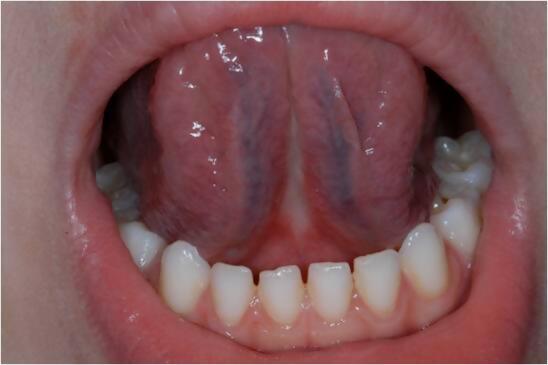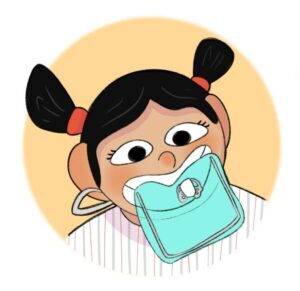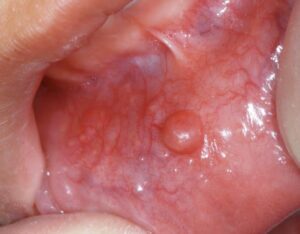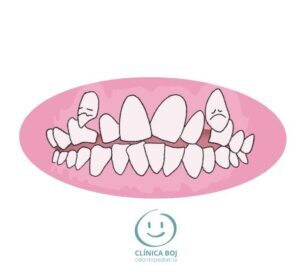Lingual frenum and when to treat it?
Lingual frenum, also known as tongue frenum, is a fibrous band that unites the lower part of the tongue with the floor of the mouth. In case the baby has tongue-tie (ankyloglossia) that restricts the movement of the tongue, as well as in other specific circumstances, lingual frenum may be removed. Ankyloglossia is a condition where the tip of the tongue is unable to tough the upper front teeth.
Know more looking at our pictures before and after the laser frenectomy procedure performed at our paediatric dentistry practice in Barcelona.
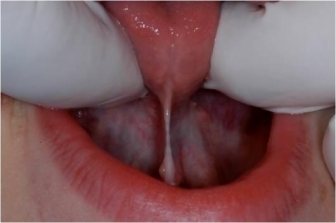
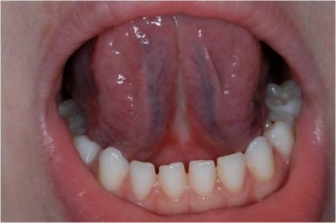
When is lingual frenulum normal?
The main function of the tongue frenum is to achieve correct eating and swallowing, as well as proper pronunciation when speaking. When the lingual frenum does not have the ideal length, we call it short lingual frenum.
What is ankyloglossia in babies?
Ankyloglossia is a congenital anomaly where lingual frenum is abnormally short or thick. In new born infants it may result in a lack of latching on to the mother’s breast for sucking. In older children it also causes problems, speech alterations among them.
At what age can tongue-tie be corrected?
In babies, we observe that the tongue does not go beyond the labial commissure at maximum opening.
This can be observed during the baby’s crying as the tongue reaches the middle of the mouth. Also, when the tongue is manipulated or raised upwards, a heart shape is observed.
What problems are associated to tongue-tie?
Tongue-tie or ankyloglossia causes a functional limitation of the tongue in varying degrees of difficulty of tongue mobility, speech disorders or problems in chewing, swallowing, or sucking.
The most frequent areas of concern are breastfeeding problems and speech difficulties, among others.
Can lingual frenulum affect speech?
Yes, lingual frenum may affect speech. There are sublingual frenums that cause language difficulties such as dyslalia or phonetic articulation disorders in the pronunciation of consonants such as r, rr, l, t, d, d, n, s, or z.
Breastfeeding problems due to tongue-tie
In the case of breastfeeding, when the frenulum of the tongue is too short, there is:
- pain in the mother’s nipple,
- incorrect latch-on by the baby at the time of breastfeeding,
- lower weight gain,
- dissatisfaction of the baby after feeding,
- nipple lesions (cracks, fissures, mastitis) or
- early abandonment of breastfeeding.
Poor oral and dental hygiene
Another problem of tongue-tie could be poor oral hygiene due to increased plaque accumulation in the lower area of the oral cavity.
In addition, we could find other consequences of ankyloglossia or tongue-tie such as:
- vomiting or easy arching due to peristalsis,
- inclination of lower incisors towards the tongue,
- malocclusions or
- oral breathing instead of proper nasal breathing.
Should I get my child´s tongue-tie fixed?
The treatment will depend on the type of lingual frenum to be treated. See “What is lingual frenulum surgery and when should it be performed“.
The types of lingual frenum that usually need surgery are:
- thin and elastic, or
- thick, fibrous and inelastic.
Other types of frenums in the mouth are the upper labial and the lower labial frenulums. You can learn more about labial frenulums in “Frenulum labialis: what is it? Problems it causes and treatments.“
Frenotomy procedure
If the frenulum of the tongue is thin and elastic, and the tongue is anchored from the tip to near the alveolar sulcus, a frenotomy will be performed. Therefore, frenotomy is a simple cutting of the frenum. The band of tissue connecting the floor of the mouth is cut (sectioned).
Frenectomy procedure
When the lingual frenulum is thick, fibrous and inelastic and the tongue is anchored from the middle or base of the tongue to the floor of the mouth or the frenulum is not visible, a frenectomy will be performed. The frenectomy procedure involves incision and removal of the entire frenum.
How is a tongue-tie problem fixed?
In the case of frenotomy, it is performed with fine-tipped scissors in newborns, babies or children. Also, laser surgery can be performed without the need for anesthetic infiltration.
However, in the case of frenectomy, it is performed under local anesthesia and the soft tissues are approached by the pediatric dentist using a cold cutting scalpel, electric scalpel, cryotherapy or laser.
In newborns and babies, after frenotomy or frenectomy, the mother can breastfeed immediately. More information in Lingual frenum in babies and breastfeeding.
Can tongue-tie surgery cause problems?
The surgery of the sublingual frenum should always be done before the child acquires maturity in language. If performed later, lingual mobility exercises should be performed after the surgery. Learn more in “What should we look for in a lingual frenum in pediatric dentistry?”
Currently, the option of using laser technology among pediatric dentists and children’s dental clinics as a replacement for other traditional surgical methods reduces the swelling of the lingual frenum once it has been treated. Read “Advantages of the use of lasers in pediatric dentistry“.
Laser technology also offers great advantages, as it facilitates fast healing, and post-surgical discomfort in the area is minimal.
References:
Boj JR, Espanya A. “Concerns of Settings Used for Low Level Therapy Laser”, PEDIATRIC DENTISTRY, 2021/1/1, Volume 43, No 1, pages 7-7. Editor AMERICAN ACADEMY PEDIATRIC DENTISTRY.
Boj JR., Poirier C., Hernandez M., Espasa E., Espanya A. “Laser soft tissue treatments for paediatric dental patients.” European archives of paediatric dentistry, 2011/4, Volume 12, No 2, pages 100-105, Editor Springer-Verlag.
Boj JR, Poirier C, Hernandez M, Espasa E, Espanya A. “Case Series: Laser treatments for soft tissue problems in children.” European Archives of Paediatric Dentistry, 2011/4/1, Volume 12, No 2, pages 113-117, Editor Springer-Verlag.


